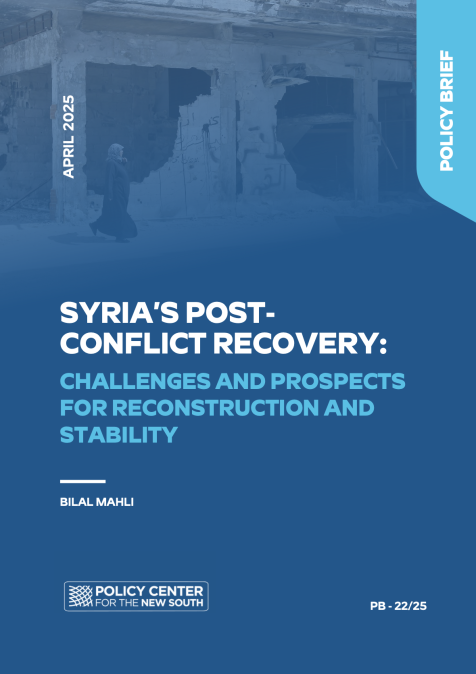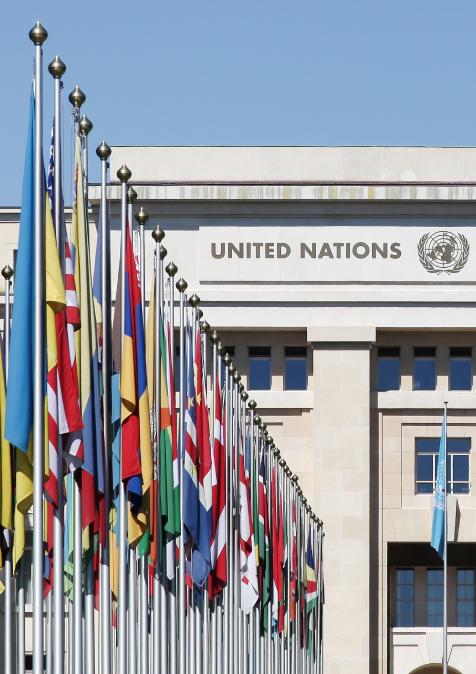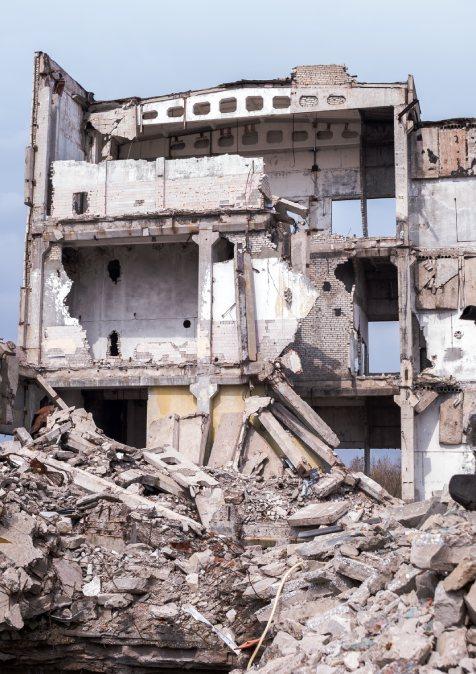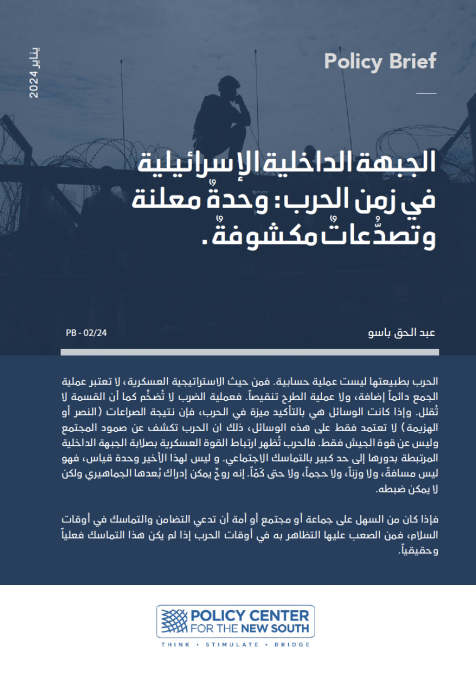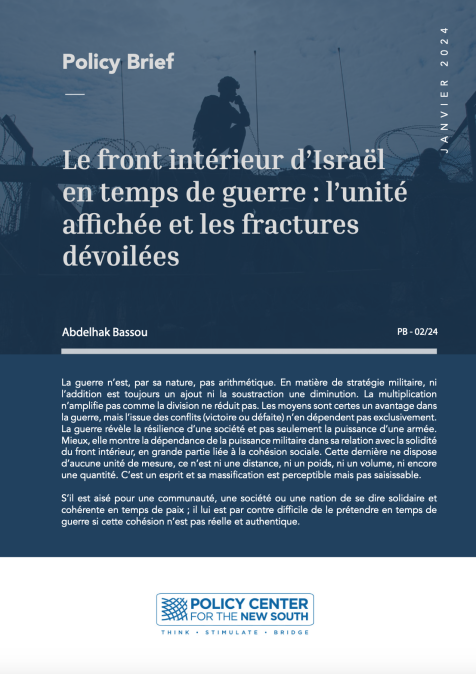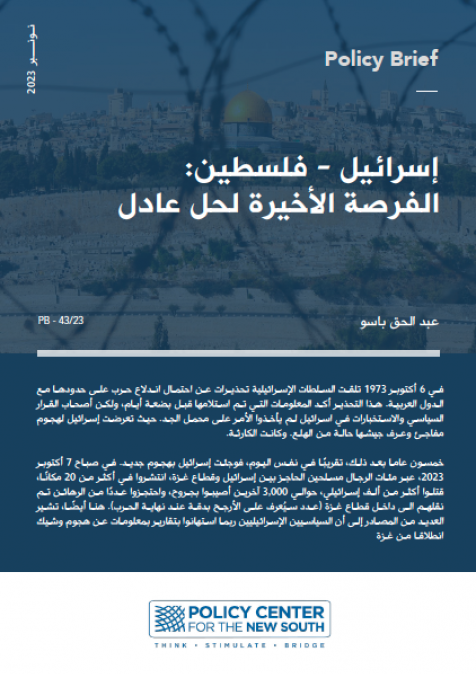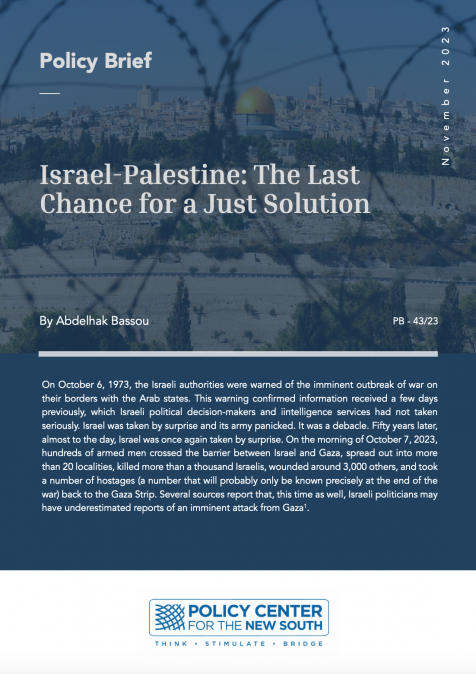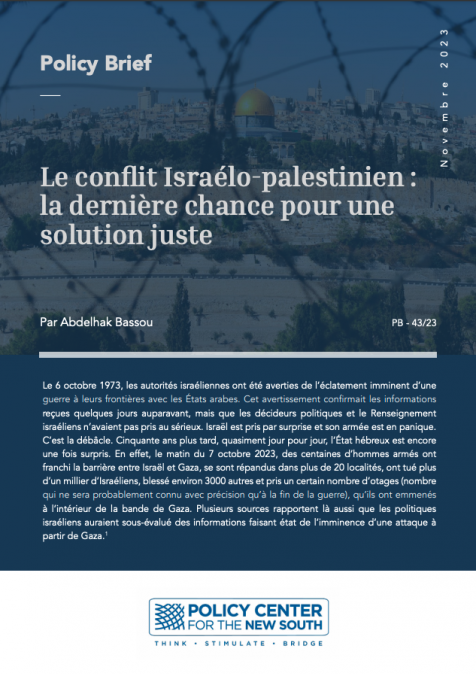Publications /
Policy Brief
Syria’s post-conflict transition, marked by the fall of the Assad regime and the appointment of interim President Ahmed al-Sharaa, will be a critical opportunity for renewal while confronting significant challenges. The country must navigate a complex landscape of political fragmentation, economic hardship, and security risks. This policy brief explores Syria’s prospects for reconstruction and long-term stability by assessing recent political reforms, economic recovery strategies, and efforts to unify the security sector. It underscores that inclusive governance, credible reform, regional cooperation, and sustained international engagement will be essential to build a stable and sovereign Syrian state.
Introduction
Syria’s transition following the fall of the Assad regime in December 2024 marks a critical juncture in the country’s modern history. After nearly fifteen years of conflict, political repression, and humanitarian catastrophe, the appointment of Ahmed al-Sharaa as transitional president has opened a window for fundamental change. Yet, this moment of potential renewal is shadowed by the immense complexity of rebuilding a deeply fragmented state. Political, economic, and security challenges are deeply intertwined, and the success of the transition will depend on whether Syria can build inclusive, legitimate institutions, while preventing a relapse into violence or authoritarianism.
At the political level, the absence of a unified opposition and the persistence of sectarian tensions pose serious obstacles to national cohesion. Diverse factions—ranging from Sunni opposition groups to Druze, Kurdish, and Alawite communities—have conflicting visions for Syria’s future. These divisions are further exacerbated by the influence of foreign powers. The Constitutional Declaration issued in March 2025 represents a formal attempt to chart a new political course, but major questions remain over the distribution of power, the protection of minority rights, and the credibility of promised reforms.
Economically, Syria faces a monumental reconstruction effort. Years of war have destroyed critical infrastructure, devastated key sectors including agriculture and manufacturing, and pushed millions into poverty. The formal economy has collapsed, while the informal sector has expanded rapidly, undermining state revenues and long-term stability. International aid and investment will be essential for recovery, but external support is likely to remain conditional on political progress, transparency, and transitional justice mechanisms.
Security remains perhaps the most fragile aspect of Syria’s post-Assad era. The presence of competing armed groups, unresolved territorial disputes, and foreign military interventions continue to destabilize the country. Efforts to integrate various militias into a unified national force have begun, but lingering mistrust and regional rivalries—particularly over Kurdish autonomy and Israeli actions in the south—pose ongoing risks.
This policy brief explores the foundational challenges of and opportunities for Syria’s transition. It assesses recent developments, including the Constitutional Declaration and emerging regional diplomacy, while analyzing the steps needed to support a stable, inclusive, and sovereign Syrian state.
Political Transition and Governance
1.1 Sectarian Challenges
Syria’s political transition following the end of the Assad regime presents one of the most critical and complex challenges for the country’s future. The transition will require the establishment of a new government, the creation of inclusive political processes, and the unification of armed factions under a national framework. These challenges are further complicated by deep political and sectarian divisions, external influences, and the potential for renewed instability if governance structures are not designed carefully.
The absence of a single, unified opposition leadership presents a fundamental problem. Various factions—opposition groups, tribal leaders, and representatives of minority communities—have diverging visions for Syria’s political future. Sectarian fragmentation is particularly stark[1]:
- Sunni Muslims (74% pre-war) were heavily targeted by the regime. Sunni-majority regions faced bombardment, displacement, and attacks on mosques.
- Shia Muslims (part of a group that includes Alawites and Ismailis, totaling 13%) benefited from Iranian support, with Tehran fostering Shia conversions and establishing recruitment centers around key shrines. Alawites dominated the pre-transition regime and now fear reprisals. They represent a significant share of the military and remain key to reconciliation.
- Druze (approx. 3%) have sought neutrality, resisting conscription and occasionally calling for autonomy.
- Christians (officially still estimated at 10%, though some reports suggest a sharp decline to 2.5%–2.8%) faced persecution from all sides and are underrepresented.
- Yezidis (from ~2,000 to ~80,000) have been nearly erased from Syria as a result of ISIS atrocities.
- Jews (no known population remaining) are virtually nonexistent.
The Assad regime exploited these divisions to maintain power, portraying itself as a protector of minorities while fueling sectarian polarization. Iran’s growing influence has further entrenched these divides, while extremist groups have also targeted minorities, making reconciliation more difficult.
1.2 The 2025 Constitutional Declaration: Laying the Foundations for Transitional Governance
The signing of Syria’s Constitutional Declaration in March 2025 by interim President Ahmed al-Sharaa marks a significant milestone in the country’s post-conflict transition. Framed as a legal roadmap toward democratic governance, the declaration sets out institutional reforms, civil-rights guarantees, and a five-year timeline for drafting a permanent constitution. However, the document has prompted debate over the concentration of executive authority, the role of religion in lawmaking, and the extent to which the political process will be inclusive of Syria’s diverse social fabric.
Executive Authority During Transition: Broad Powers with Limited Oversight
Under the declaration, the interim president is granted considerable powers throughout the transitional period. These include the authority to declare a state of emergency and to appoint one-third of the transitional legislature. The remaining members are to be selected through elections administered by a presidentially appointed commission. While this structure ensures a degree of institutional continuity and central coordination, it raises questions about checks and balances, especially given Syria’s history of executive dominance.
The president also appoints ministers, directs the armed forces, and plays a central role in shaping the legislative process. This concentration of power may raise concerns about entrenching hierarchical decision-making rather than fostering participatory governance. The transitional framework lacks clear mechanisms to ensure that executive authority will be progressively curtailed as institutions stabilize.
Judicial Reform and the Role of the Constitutional Court
The declaration abolishes special courts and establishes a new Supreme Constitutional Court, signaling an effort to enhance judicial independence. However, the president has exclusive authority to appoint its members, without institutional vetting or external oversight. Although the declaration emphasizes impartiality in judicial proceedings, the absence of a transparent appointment process raises concerns about the judiciary’s autonomy and its ability to serve as a meaningful check on executive power during the transition.
Islamic Law and Religious Freedoms: Continuity with Modifications
The Constitutional Declaration retains provisions from the former constitution that establish Islamic law as the principal source of legislation and require the president to be Muslim. At the same time, it guarantees freedom of belief and the protection of personal-status laws for religious communities. However, the invocation of national security or public order as grounds for limiting rights introduces potential ambiguity, which may impact the consistent application of freedoms.
Minority Rights and Political Inclusion: Promises Versus Perceptions
The declaration formally commits to equality and non-discrimination. However, some minority groups have expressed concern over how these provisions will be implemented in practice. Kurdish political representatives, in particular, have criticized the transitional framework for preserving authoritarian structures in a new form. The Syrian Democratic Council described the declaration as insufficiently inclusive and pointed to the lack of guarantees for decentralized governance or representation of regional authorities[2]. Ongoing inter-communal tensions and local unrest in several parts of the country underscore the fragility of national unity during this phase.
Economic Reconstruction
2.1 Infrastructure and Sectoral Damage
Years of war have inflicted extensive damage on Syria's infrastructure, damaging roads, power grids, water systems, hospitals, and schools, particularly in cities including Aleppo, Raqqa, and Homs. The estimated reconstruction cost ranges between $250 billion and $400 billion, far exceeding Syria’s fiscal capacity[3]. Key economic sectors, notably agriculture, manufacturing, and services, have also been disrupted. Agriculture, once central to food security and rural employment, has suffered from destroyed irrigation systems and displaced populations. Industrial zones around Damascus, Aleppo, and Homs face physical destruction and capital flight.
According to the World Bank’s ‘Syria Economic Monitor, Spring 2024’, Syria continues to grapple with GDP decline, inflation, and worsening poverty. The Syrian pound depreciated 141% against the US dollar in 2023, fueling inflation and making essential goods unaffordable[4]. Exports fell from $8.8 billion in 2010 to $1 billion in 2023; imports dropped from $17.5 billion to $3.2 billion, further widening the trade deficit[5]. Humanitarian aid remains insufficient, with only $2.8 billion raised in 2023—just one-third of the estimated need. As of 2022, 25% of Syrians live in extreme poverty[6].
Infrastructure damage, a shrinking revenue base, and limited external funding hinder recovery efforts. The 2023 earthquake compounded the destruction of utilities and transportation networks. Syrian oil production plummeted from 383,000 barrels per day in 2010 to 90,000 in 2023, stripping the government of a critical revenue stream[7].
2.2 Pathways to Economic Stabilization
Reviving domestic production and employment is critical to economic stabilization. Business closures caused by insecurity and resource scarcity have stalled productivity. Support for micro, small, and medium-sized enterprises (MSMEs), which once comprised 95% of Syrian businesses and 60% of GDP, is vital[8]. Their current contribution has declined to 40%, though they still employ 70% of the workforce and offer a crucial buffer against poverty[9].
The informal economy has grown substantially, with black-market transactions filling gaps left by institutional collapse. By 2021, the Syrian pound had depreciated 82-fold on the black market compared to pre-war levels[10]. Inflation spiked at 140% from mid-2019 to mid-2020[11]. This shift undermined fiscal capacity and complicated tax collection. Rebuilding trust in formal institutions and financial systems is essential.
According to World Bank national accounts data, the Syrian Arab Republic experienced a sharp economic contraction beginning in 2012, with GDP shrinking by over 26% in both 2012 and 2013. Although the rate of decline slowed in subsequent years, the economy remained unstable, with only modest positive growth recorded between 2018 and 2022. Overall, the data reflect the prolonged economic impact of the conflict that began in 2011[12]:

2.3 International Aid and Investment
Post-war recovery depends on external financial support, but geopolitical divisions and legal complexities remain as barriers. Sanctions, a fractured banking system, and institutional collapse limit access to capital. Western donors and institutions are likely to make aid conditional on democratic reforms, human rights, and accountability mechanisms.
Foreign direct investment (FDI) is essential but constrained by legal ambiguity, political instability, and weak rule of law. Destroyed land registries and mass displacement complicate property rights, discouraging investors. Without legal clarity and dispute resolution mechanisms, large-scale FDI remains improbable.
Sanctions further impede economic reintegration. While many measures target regime-affiliated actors, broader financial restrictions remain in place. The prospect of easing sanctions under a transitional government is uncertain. Nonetheless, there are signs of flexibility. The EU has proposed a conditional, phased roadmap for sanctions relief tied to governance and human rights milestones[13]. Canada pledged $84 million in aid and introduced a six-month sanctions-easing period[14]. The U.S. issued General License 24 (January 2025), permitting limited transactions to support humanitarian and public services while maintaining core sanctions[15].
At the ninth Brussels Conference (March 17, 2025), donors pledged €5.8 billion in support of Syria’s transition. The EU and its member states contributed nearly €3.4 billion, underscoring Europe's central role in Syria’s recovery under strict political conditions[16].
2.4 Regional Economic Re-engagement
Syria’s recovery also depends on reintegration into regional economic networks. Before the war, Syria maintained strong trade ties with Lebanon, Jordan, Iraq, and Türkiye. The conflict disrupted these routes, weakening the agriculture, manufacturing, and energy sectors.
Recent diplomatic efforts show renewed regional interest in Syria’s reconstruction. Qatar, Saudi Arabia, and the UAE have shifted from isolation to engagement. Qatar’s Emir Sheikh Tamim bin Hamad Al-Thani visited Damascus in January 2025, becoming the first head of state to meet President Ahmed al-Sharaa[17]. Saudi Arabia hosted President al-Sharaa in Riyadh, discussing cooperation in energy, education, and technology[18]. UAE Foreign Minister Sheikh Abdullah Bin Zayed met Syrian Foreign Minister Asaad al-Shibani in Dubai during the World Governments Summit[19].
European re-engagement is also underway. On January 3, 2025, the French and German foreign ministers visited Damascus to meet with al-Sharaa, affirming support for democratic transition[20]. Germany reopened its embassy in Damascus on March 20, 2025[21]. These moves reflect a convergence of regional and European strategies aimed at pragmatic engagement and gradual normalization.
Reviving trade routes, restoring diplomatic ties, and forming regional partnerships will be pivotal. Yet these efforts hinge on political developments within Syria and the transitional government’s credibility.
Security and Stability
3.1 Fragmented Armed Landscape
Syria’s post-Assad security landscape is defined by fragmentation, terrorism, and foreign interference. Multiple armed groups continue to operate across the country, each with its own agenda and external backers. Key actors include:
- Hayat Tahrir al-Sham (HTS): A former al-Qaeda affiliate that played a central role in Assad’s ouster. Its former leader, Ahmed al-Sharaa, now heads the transitional government as interim president following the dissolution of HTS on January 29, 2025. Western countries remain divided on lifting HTS’s terrorist designation, despite its integration into state institutions.
- Syrian Democratic Forces (SDF): A Kurdish-led coalition previously backed by the U.S., now resisting full integration into the national army. Türkiye considers the SDF a threat and continues to carry out cross-border operations.
- Syrian National Army (SNA): A Türkiye-backed militia coalition operating in northern Syria, noted for its decentralized command structure and diverse ideological composition.
- Druze Militias: Recently mobilized in southern Syria, especially around Suwayda, they demand local autonomy and resist centralization.
- ISIS: Though militarily weakened, ISIS continues to operate as an insurgency, with sleeper cells launching attacks primarily in the northeast.
The map shows the ethnic composition of Syria, which helps explain some of the underlying tensions shaping conflict dynamics in different regions[22]:
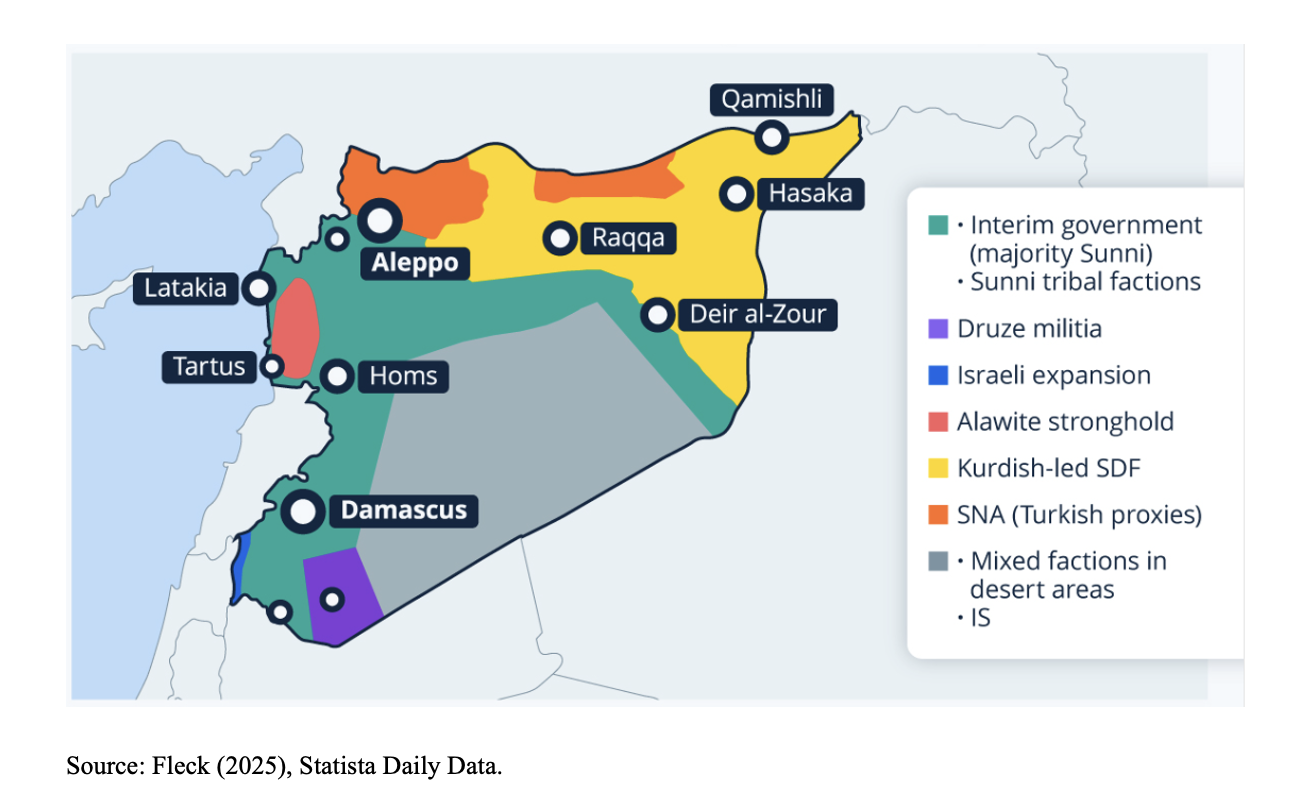
Northern Syria: Sectarian Flashpoints: Aleppo remains a volatile hotspot. In March 2025, a pro-Assad ambush triggered intense clashes, killing over 1,000 people, including 745 civilians. Sectarian tensions surged, particularly affecting Alawite communities, which fear marginalization[23]. Disarmament efforts have stalled as these communities hold back from surrendering arms, perceiving the Sunni-led transitional government as a threat. This deep mistrust has undermined national reconciliation and stalled disarmament, demobilization, and reintegration (DDR) efforts.
Northeastern Syria: Kurdish Autonomy and Turkish Pressure: The SDF continues to govern northeastern Syria independently. A unilateral ceasefire implemented by the PKK on March 1, 2025, followed by calls for disarmament from imprisoned leader Abdullah Öcalan, was met with skepticism in Ankara. Türkiye launched further operations targeting what it views as PKK-linked positions in Syria and Iraq[24]. Strategic locations, such as the Tishreen Dam and border regions, remain contested. The status of prisons holding ISIS fighters remains a security concern, with fears of breakouts and renewed insurgency.
Southern Syria: Israeli Involvement and Regional Tensions: In the south, particularly near the Golan Heights, Israel has increased its presence under the banner of humanitarian outreach[25]. Simultaneously, it continues targeted strikes against Iranian-linked militias. While framed as stabilization, many Syrians view this as a form of soft occupation. Protests erupted in towns such as Jaramana, especially among the Druze, denouncing Israeli actions and reaffirming a commitment to national unity. Israel’s involvement raises the risk of broader regional escalation, particularly if Iranian proxies retaliate[26].
3.2 Disarmament, Demobilization, and Reintegration
In December 2024, the transitional government announced a plan to merge rebel groups under the Ministry of Defense[27]. The SDF was initially excluded but later, on March 10, 2025, signed a groundbreaking agreement to gradually integrate its forces and governance structures into national institutions. This includes shared control over oil and gas infrastructure. The government pledged political representation and local governance rights in return[28].
Syria’s interim government has reportedly reached an agreement to integrate the Druze-majority province of Sweida into national institutions, granting residents access to civil-service roles and placing local security under the Interior Ministry’s authority[29]. While tentative, these deals signal the possibility of decentralized governance arrangements that could serve as models for other minority regions.
3.3 Terrorism and Localized Violence
Despite territorial defeat, ISIS retains operational capacity, especially in under-governed areas. Attacks on checkpoints and infrastructure have increased[30]. Extremist propaganda still finds an audience in displacement camps and prisons, where radicalization is fostered by poor conditions and lack of oversight.
Other local militias, tribal forces, and warlords remain active, driven by fear of marginalization or political exclusion. Their resistance to central authority risks entrenching a patchwork of governance zones, undermining national unity.
3.4 Outlook for Security Reform
The creation of a unified national security apparatus remains a distant goal. Successful reform depends on building trust across ethnic and sectarian lines, enforcing DDR agreements, and professionalizing the military and police. International support, including technical training and demobilization funding, will be essential. Regional actors must also be persuaded to scale back proxy engagement to create space for stabilization.
Without a sustained and inclusive strategy, Syria risks descending into a new cycle of fragmented violence, obstructing political transition and reconstruction.
Conclusion
Syria stands at a crossroads. While the fall of the Assad regime and the introduction of a transitional government provide an opportunity for renewal, the country faces deep-rooted political, economic, and security challenges. The 2025 Constitutional Declaration outlines an ambitious reform agenda and its implementation will be key to restoring legitimacy and trust. Inclusive political processes, credible transitional justice, and a transparent electoral framework must underpin the transition.
Simultaneously, economic recovery will require coordinated reconstruction efforts, regional reintegration, and significant external support. Without legal clarity, stable institutions, and political buy-in from diverse communities, investment and recovery will stall. On the security front, de-escalation, DDR initiatives, and unified national command structures will be critical to prevent fragmentation.
The involvement of regional actors—through both competition and cooperation—will continue to shape Syria’s trajectory. Gulf states, Türkiye, and European powers must coordinate their efforts and avoid zero-sum rivalries. Constructive multilateral engagement will be necessary to ensure that Syria’s reintegration into regional and global systems is sustainable and respectful of national sovereignty.
The years ahead will determine whether Syria can move from conflict to coexistence, from fragmentation to unity. The promise of a new political and social contract exists—but fulfilling it will require compromise, resilience, and inclusive vision. With committed domestic leadership and genuine international support, Syria may yet realize the hope of a just and lasting peace.
Bibliography
- Abdullah Bin Zayed, Syrian FM discuss enhancing relations. (2025, February 11). United Arab Emirates Ministry of Foreign Affairs. https://www.mofa.gov.ae/en/mediahub/news/2025/2/11/11-2-2025-uae-syria
- Ahmad, J., & AlaaElDin, M. (2025, March 10). Syria’s interim president signs deal with Kurdish-led SDF to merge forces. Reuters. https://www.reuters.com/world/middle-east/syria-reaches-deal-integrate-sdf-within-state-institutions-presidency-says-2025-03-10/
- Al Jazeera. (2025, February 2). Syria’s President al-Sharaa meets Saudi Arabia’s MBS in first foreign trip. Al Jazeera. https://www.aljazeera.com/news/2025/2/2/syrias-president-al-sharaa-meets-saudi-arabias-mbs-in-first-foreign-trip
- Al Jazeera. (2024, December 24). Syria says ex-rebel groups agree to integrate under Defence Ministry. Al Jazeera. https://www.aljazeera.com/news/2024/12/24/syria-says-ex-rebel-groups-agree-to-integrate-under-defence-ministry
- Bahah, M. (2025, March 3). Defending the Druze: Israel's pretext to divide the new Syria. The New Arab. https://www.newarab.com/analysis/defending-druze-israels-pretext-divide-new-syria
- Christou, W. (2025, March 9). More than 1,000 people killed in two days of clashes in Syria, war monitor says. The Guardian. https://www.theguardian.com/world/2025/mar/09/more-than-1000-people-killed-in-two-days-of-clashes-in-syria-war-monitor-says
- European Commission. (2025, March 18). The EU mobilises international support for Syria’s transition and the region raising €5.8 billion. ec.europa.eu. https://ec.europa.eu/commission/presscorner/detail/en/ip_25_795
- Fleck, A. (2025, March 14). Syria’s sectarian divides. Statista Daily Data. https://www.statista.com/chart/31468/ethnic-religious-groups-and-areas-of-control-in-syria/
- GDP growth (annual %) - Syrian Arab Republic. (n.d.). World Bank Open Data. Retrieved March 26, 2025, from https://data.worldbank.org/indicator/NY.GDP.MKTP.KD.ZG?end=2022&locations=SY&start=2011
- Government of Canada. (2025, March 12). Backgrounder: Canada announces measures and support for the people of Syria. Canada.ca. https://www.canada.ca/en/global-affairs/news/2025/03/backgrounder-canada-announces-measures-and-support-for-the-people-of-syria.html
- Hubenko, D. (2025, March 20). Germany reopens embassy in Syria after 13-year closure. dw.com. https://www.dw.com/en/germany-reopens-embassy-in-syria-after-13-year-closure/a-71985073
- Israel sends aid to Druze in Syria, foreign ministry says. (2025, March 13). Reuters. https://www.reuters.com/world/middle-east/israel-sends-humanitarian-aid-druze-syria-foreign-ministry-says-2025-03-13/
- Kozul-Wright, A. (2025, January 8). Rebuilding Syria’s economy: Can stability return after war? Al Jazeera. https://www.aljazeera.com/economy/2025/1/8/rebuilding-syrias-economy-can-stability-return-after-war
- Kurdish-led Syrian group rejects Islamist authorities’ new constitution framework. (2025, March 14). Reuters. https://www.reuters.com/world/middle-east/kurdish-led-syrian-group-rejects-islamist-authorities-new-constitution-framework-2025-03-14/
- Onder, H. (2021). A DECADE OF WAR IN SYRIA: THE ECONOMIC SIDE A retrospective for the World Bank’s “Syria Analytical Roadmap.” In The World Bank. Retrieved February 11, 2025, from https://thedocs.worldbank.org/en/doc/ebb9b060753b7019705d1dafe9fe2e35-0280032021/original/April-22-Harun-OnderA-Decade-of-War-in-Syria-The-Economic-Side.pdf
- Reuters. (2025, January 30). Qatar’s Emir visits Syria, first head of state to visit Damascus since Assad’s fall. Reuters. https://www.reuters.com/world/middle-east/qatars-emir-visit-damascus-thursday-al-jazeera-says-2025-01-30/
- Roussi, A. (2025, March 19). As Trump cuts aid, EU leaders make plans to contain ISIS-linked camps. POLITICO. https://www.politico.eu/article/donald-trump-foreign-aid-cuts-eu-isis-camps-al-hol-roj/
- Sallon, H. (2025b, January 4). France and Germany will judge Syria’s new regime “by its actions.” Le Monde.fr. https://www.lemonde.fr/en/international/article/2025/01/04/france-and-germany-will-judge-syria-s-new-regime-by-its-actions_6736699_4.html
- Syrian government said to reach deal to fully integrate southern Druze province. (2025, March 11). Times of Israel. https://www.timesofisrael.com/syrian-government-said-to-reach-deal-to-fully-integrate-southern-druze-province/
- Turkey says 26 PKK militants were killed in military operations despite peace efforts | AP News. (2025, March 6). AP News. Retrieved March 25, 2025, from https://apnews.com/article/turkey-pkk-26-killed-despite-peace-effort-20bb8a81db3a5d71b759a1eef0cbc90d
- UNDP. (2023, June 27). Five reasons why MSMEs are important for Syria’s economic recovery and social development. Retrieved February 11, 2025, from https://www.undp.org/arab-states/stories/five-reasons-why-msmes-are-important-syrias-economic-recovery-and-social-development
- United States Department of State • Office of International Religious Freedom. (2023). 2023 Report on International Religious Freedom: Syria. In United States Department of State. https://www.state.gov/reports/2023-report-on-international-religious-freedom/syria/
- U.S. Treasury Issues Additional Sanctions Relief for Syrian People. (2025, January 6). U.S. Department of The Treasury. Retrieved March 20, 2025, from https://home.treasury.gov/news/press-releases/jy2770#:~:text=U.S.%20Treasury%20Issues%20Additional%20Sanctions%20Relief%20for%20Syrian%20People,-January%206%2C%202025&text=WASHINGTON%20%E2%80%94%20Today%2C%20the%20Department%20of,Syria%20following%20December%208%2C%202024.
- World Bank. Syria Economic Monitor, Spring 2024 : Conflict, Crises, and the Collapse of Household Welfare (English). Washington, D.C. : World Bank Group. http://documents.worldbank.org/curated/en/099515505222471242
[1] United States Department of State • Office of International Religious Freedom. (2023). 2023 Report on International Religious Freedom: Syria. In United States Department of State. https://www.state.gov/reports/2023-report-on-international-religious-freedom/syria/
[2] Kurdish-led Syrian group rejects Islamist authorities’ new constitution framework. (2025, March 14). Reuters. https://www.reuters.com/world/middle-east/kurdish-led-syrian-group-rejects-islamist-authorities-new-constitution-framework-2025-03-14/
[3] Kozul-Wright, A. (2025, January 8). Rebuilding Syria’s economy: Can stability return after war? Al Jazeera. https://www.aljazeera.com/economy/2025/1/8/rebuilding-syrias-economy-can-stability-return-after-war
[4] World Bank. Syria Economic Monitor, Spring 2024 : Conflict, Crises, and the Collapse of Household Welfare (English). Washington, D.C. : World Bank Group. http://documents.worldbank.org/curated/en/099515505222471242
[5] Ibid.
[6] Ibid.
[7] Ibid.
[8] UNDP. (2023, June 27). Five reasons why MSMEs are important for Syria’s economic recovery and social development. Retrieved February 11, 2025, from https://www.undp.org/arab-states/stories/five-reasons-why-msmes-are-important-syrias-economic-recovery-and-social-development
[9] Ibid.
[10] Onder, H. (2021). A DECADE OF WAR IN SYRIA: THE ECONOMIC SIDE A retrospective for the World Bank’s “Syria Analytical Roadmap.” In The World Bank. Retrieved February 11, 2025, from https://thedocs.worldbank.org/en/doc/ebb9b060753b7019705d1dafe9fe2e35-0280032021/original/April-22-Harun-OnderA-Decade-of-War-in-Syria-The-Economic-Side.pdf
[11] Ibid.
[12] GDP growth (annual %) - Syrian Arab Republic. (n.d.). World Bank Open Data. Retrieved March 26, 2025, from https://data.worldbank.org/indicator/NY.GDP.MKTP.KD.ZG?end=2022&locations=SY&start=2011
[13] Liboreiro, J., & Psara, M. (2025, January 27). EU agrees on “step-by-step” roadmap to start easing sanctions on Syria. Euronews. https://www.euronews.com/my-europe/2025/01/27/eu-countries-agree-to-ease-banking-energy-and-transport-sanctions-on-syria
[14] Government of Canada. (2025, March 12). Backgrounder: Canada announces measures and support for the people of Syria. Canada.ca. https://www.canada.ca/en/global-affairs/news/2025/03/backgrounder-canada-announces-measures-and-support-for-the-people-of-syria.html
[15] U.S. Treasury Issues Additional Sanctions Relief for Syrian People. (2025, January 6). U.S. Department of The Treasury. Retrieved March 20, 2025, from https://home.treasury.gov/news/press-releases/jy2770#:~:text=U.S.%20Treasury%20Issues%20Additional%20Sanctions%20Relief%20for%20Syrian%20People,-January%206%2C%202025&text=WASHINGTON%20%E2%80%94%20Today%2C%20the%20Department%20of,Syria%20following%20December%208%2C%202024.
[16] European Commission. (2025, March 18). The EU mobilises international support for Syria’s transition and the region raising €5.8 billion. ec.europa.eu. https://ec.europa.eu/commission/presscorner/detail/en/ip_25_795
[17] Reuters. (2025, January 30). Qatar’s Emir visits Syria, first head of state to visit Damascus since Assad’s fall. Reuters. https://www.reuters.com/world/middle-east/qatars-emir-visit-damascus-thursday-al-jazeera-says-2025-01-30/
[18] Al Jazeera. (2025, February 2). Syria’s President al-Sharaa meets Saudi Arabia’s MBS in first foreign trip. Al Jazeera. https://www.aljazeera.com/news/2025/2/2/syrias-president-al-sharaa-meets-saudi-arabias-mbs-in-first-foreign-trip
[19] Abdullah Bin Zayed, Syrian FM discuss enhancing relations. (2025, February 11). United Arab Emirates Ministry of Foreign Affairs. https://www.mofa.gov.ae/en/mediahub/news/2025/2/11/11-2-2025-uae-syria
[20] Sallon, H. (2025b, January 4). France and Germany will judge Syria’s new regime “by its actions.” Le Monde.fr. https://www.lemonde.fr/en/international/article/2025/01/04/france-and-germany-will-judge-syria-s-new-regime-by-its-actions_6736699_4.html
[21] Hubenko, D. (2025, March 20). Germany reopens embassy in Syria after 13-year closure. dw.com. https://www.dw.com/en/germany-reopens-embassy-in-syria-after-13-year-closure/a-71985073
[22] Fleck, A. (2025, March 14). Syria’s sectarian divides. Statista Daily Data. https://www.statista.com/chart/31468/ethnic-religious-groups-and-areas-of-control-in-syria/
[23] Christou, W. (2025, March 9). More than 1,000 people killed in two days of clashes in Syria, war monitor says. The Guardian. https://www.theguardian.com/world/2025/mar/09/more-than-1000-people-killed-in-two-days-of-clashes-in-syria-war-monitor-says
[24] Turkey says 26 PKK militants were killed in military operations despite peace efforts | AP News. (2025, March 6). AP News. Retrieved March 25, 2025, from https://apnews.com/article/turkey-pkk-26-killed-despite-peace-effort-20bb8a81db3a5d71b759a1eef0cbc90d
[25] Israel sends aid to Druze in Syria, foreign ministry says. (2025, March 13). Reuters. https://www.reuters.com/world/middle-east/israel-sends-humanitarian-aid-druze-syria-foreign-ministry-says-2025-03-13/
[26] Bahah, M. (2025, March 3). Defending the Druze: Israel's pretext to divide the new Syria. The New Arab. https://www.newarab.com/analysis/defending-druze-israels-pretext-divide-new-syria
[27] Al Jazeera. (2024, December 24). Syria says ex-rebel groups agree to integrate under Defence Ministry. Al Jazeera. https://www.aljazeera.com/news/2024/12/24/syria-says-ex-rebel-groups-agree-to-integrate-under-defence-ministry
[28] Ahmad, J., & AlaaElDin, M. (2025, March 10). Syria’s interim president signs deal with Kurdish-led SDF to merge forces. Reuters. https://www.reuters.com/world/middle-east/syria-reaches-deal-integrate-sdf-within-state-institutions-presidency-says-2025-03-10/
[29] Syrian government said to reach deal to fully integrate southern Druze province. (2025, March 11). Times of Israel. https://www.timesofisrael.com/syrian-government-said-to-reach-deal-to-fully-integrate-southern-druze-province/
[30] Roussi, A. (2025, March 19). As Trump cuts aid, EU leaders make plans to contain ISIS-linked camps. POLITICO. https://www.politico.eu/article/donald-trump-foreign-aid-cuts-eu-isis-camps-al-hol-roj/

